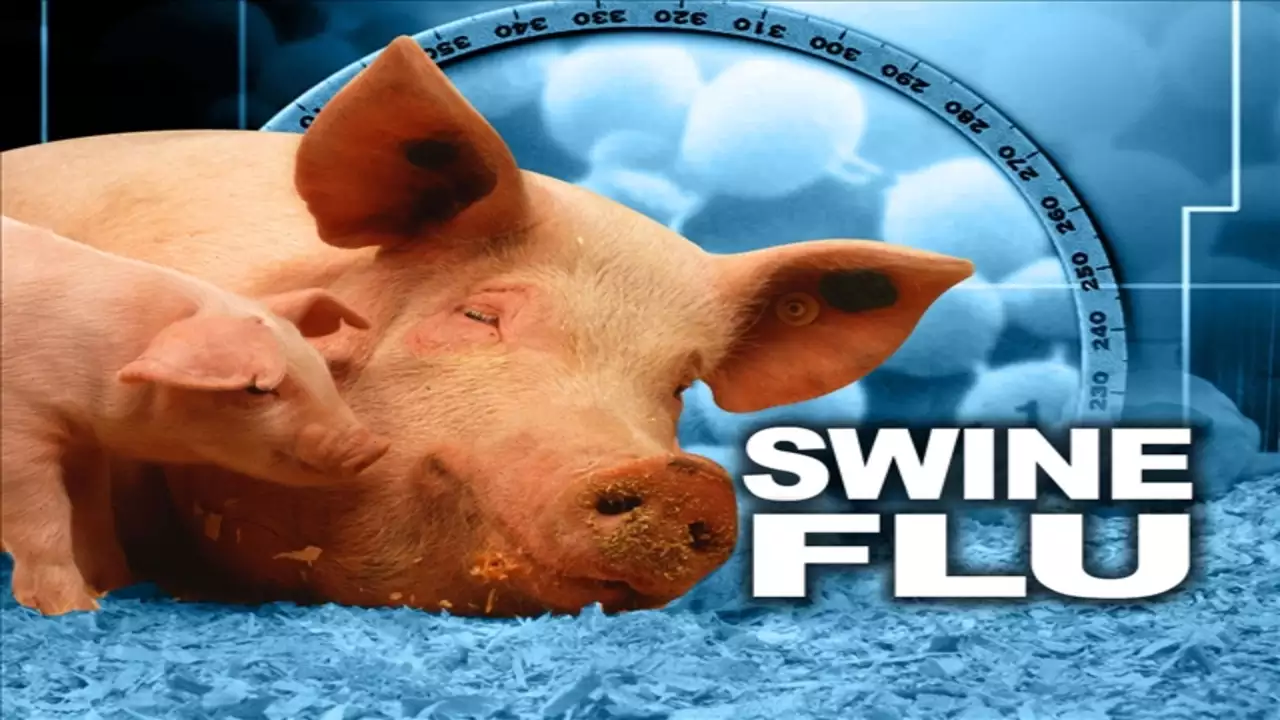Swine Flu and Normal Flu are both respiratory illnesses caused by influenza viruses, yet they emerge from different strains and have distinct historical contexts. Swine Flu, primarily associated with the H1N1 strain, rose to global prominence during the 2009 pandemic, originating from a combination of swine, avian, and human influenza viruses. On the other hand, Normal Flu refers to the recurrent seasonal flu caused by various strains, including H1N1, H3N2, and influenza B viruses, that affect populations annually. Recognizing the differences and similarities between the two is crucial for diagnosis, treatment, and prevention.
Swine Flu
Swine flu refers to a respiratory disease of pigs caused by type A influenza viruses. While it regularly causes outbreaks in pigs, the term became popularly associated with the influenza pandemic of 2009 when a new strain of the H1N1 subtype emerged. This strain was a unique combination of influenza virus genes never previously identified in either animals or humans.

While it was initially termed “swine flu” because laboratory testing showed many of its genes were similar to influenza viruses that normally occur in pigs, further research determined it spread more readily among humans. It’s important to note that the virus was not contracted by eating pork or pork products and, after the initial outbreaks, primarily spread from person to person like other flu viruses.
Causes of Swine Flu
Causes of Swine Flu:
Swine flu is caused by a strain of influenza type A virus. The most well-known case that affected humans, leading to the 2009 pandemic, was the H1N1 virus. Here’s a breakdown:
- Origin in Pigs: The H1N1 virus that causes swine flu originally infected only pigs. Swine flu viruses may mutate or combine with other flu viruses, leading to new variants.
- Transmission to Humans: On rare occasions, a person working closely with pigs, such as a farmer or pork processor, would contract the virus. However, the 2009 H1N1 strain had genes from flu viruses that normally occur in pigs, birds, and humans.
- Human to Human Transmission: The significant concern during the 2009 pandemic was that this strain of the H1N1 virus was easily transmissible among humans. It spread in the same way as the seasonal flu, primarily through droplets when an infected person coughed or sneezed.
- Virus Evolution: The 2009 H1N1 virus was a unique combination of influenza virus genes never previously identified in either animals or humans. It had genes from flu viruses that affect birds, swine, and humans.
While the origin of the 2009 H1N1 pandemic was linked to pigs, the transmission and widespread nature of the disease were due to human-to-human contact. Consuming properly cooked pork or pork products was not a risk for the transmission of the H1N1 virus.
Symptoms of Swine Flu
Swine flu manifests with symptoms similar to those of the regular flu:
- Fever
- Cough
- Sore throat
- Runny or stuffy nose
- Body aches
- Headache
- Chills
- Fatigue
- In some cases, it can also lead to diarrhea and vomiting.
Severe symptoms, such as difficulty breathing, persistent chest pain, confusion, or sudden dizziness, should be treated as emergencies. It’s important to consult a healthcare professional if you suspect you’ve contracted swine flu, especially if symptoms are severe.
Normal Flu
Normal flu, more commonly known as seasonal influenza, is a contagious respiratory illness caused by influenza viruses that infect the nose, throat, and sometimes the lungs. It can cause mild to severe illness and can lead to hospitalization and death. The term “normal” or “seasonal” distinguishes this common flu that circulates annually, leading to seasonal epidemics, from other pandemic strains like swine flu.

Seasonal influenza is caused by several strains, including H1N1, H3N2, and influenza B viruses, with its severity and prevalent strain varying each year. It spreads mainly through droplets from a person who is coughing or sneezing and can be effectively combated with annual flu vaccines, which are adjusted yearly based on anticipated strains.
Causes of Normal Flu
The normal or seasonal flu is caused by influenza viruses. There are four main types of influenza viruses (A, B, C, and D), but types A and B are the primary culprits behind the seasonal flu epidemics in humans. Here’s a breakdown:
- Influenza Type A Viruses: These can be found in multiple species, including humans, birds, pigs, horses, and others. They’re the most variable and can be further classified into subtypes based on the surface proteins hemagglutinin (H) and neuraminidase (N). Examples include H1N1 and H3N2. Due to their variability, they’re responsible for major flu pandemics.
- Influenza Type B Viruses: Mainly affect humans and are responsible for a significant portion of seasonal flu cases. They might lead to smaller outbreaks and are generally less severe than type A, but can still cause epidemics. They’re categorized by lineage rather than subtype, with the two main lineages being B/Victoria and B/Yamagata.
- Transmission: The flu viruses spread primarily through tiny droplets made when people with the flu cough, sneeze, or talk. These droplets can land in the mouths or noses of individuals nearby. Less often, people might contract the flu by touching a surface or object with flu virus on it and then touching their own mouth, nose, or possibly eyes.
- Seasonal Changes: Influenza viruses undergo frequent genetic changes, leading to new strains. Our immune system’s ability to recognize and fend off the virus diminishes when the virus changes, making it possible for people to get sick from the flu multiple times during their lives.
Vaccination remains the most effective means to prevent infection or reduce the severity of the illness.
Symptoms of Normal Flu
Symptoms of Normal Flu:
- Fever or feeling feverish/chills
- Cough
- Sore throat
- Runny or stuffy nose
- Muscle or body aches
- Headaches
- Fatigue (tiredness)
- Some people may experience vomiting and diarrhea, though this is more common in children.
These symptoms typically come on suddenly. While they overlap with many other viral illnesses, the intensity and combination of symptoms can help differentiate the flu from common colds or other respiratory infections. Always consult a healthcare professional for an accurate diagnosis.
Comparison table of Swine Flu and Normal Flu
There are comparison table of swine flu and normal flu:
| Criteria | Swine Flu | Normal Flu |
|---|---|---|
| Causative Agent | Predominantly H1N1 virus strain from the 2009 pandemic | Influenza Type A (e.g., H1N1, H3N2) and Type B viruses |
| Origins | Combination of bird, pig, and human flu viruses (2009 strain) | Regularly circulating flu viruses |
| Transmission | Human-to-human; rare cases from infected pigs | Mainly human-to-human |
| Common Symptoms | – Fever
– Cough – Sore throat – Runny or stuffy nose – Body aches – Headaches – Fatigue – Diarrhea and vomiting (in some cases) |
– Fever or feeling feverish/chills
– Cough – Sore throat – Runny or stuffy nose – Muscle or body aches – Headaches – Fatigue |
| High-Risk Groups (2009) | Younger populations, pregnant women | Very young, elderly, immunocompromised, and those with chronic health conditions |
| Vaccination | Specific H1N1 vaccine developed for the pandemic | Annual flu shots based on anticipated dominant strains |
| Treatment | Antiviral medications (e.g., oseltamivir) | Antiviral medications (e.g., oseltamivir) |
| Major Outbreak | 2009 pandemic | Annual seasonal outbreaks |
While this table provides a comparative overview, the actual presentation and severity of both flus can vary based on individual cases, and the strains of the viruses might change over time.
Similarities between Swine Flu and Normal Flu
Similarities between Swine Flu and Normal Flu:
- Nature: Both are caused by influenza viruses.
- Transmission: Spread primarily through respiratory droplets and contact with contaminated surfaces.
- Symptoms: Include fever, cough, sore throat, runny/stuffy nose, body aches, headaches, fatigue, and sometimes vomiting and diarrhea.
- Treatment: Both can be treated with antiviral medications like oseltamivir.
- Prevention: Vaccination and good hygiene practices are effective for both.
- Complications: Both can lead to severe complications like pneumonia and respiratory failure, especially in high-risk groups.
- At-Risk Populations: Include the very young, elderly, pregnant women, and those with underlying health conditions.
Treatment Options for Swine Flu and Normal Flu
Treatment options for both Swine Flu (H1N1) and Normal (seasonal) Flu are relatively similar, given they’re both caused by influenza viruses.

Here’s a breakdown:
1. Antiviral Medications:
- Oseltamivir (Tamiflu): This is an oral medication that’s most effective when started within the first 48 hours of symptom onset. It can reduce the severity and duration of the flu.
- Zanamivir (Relenza): This is an inhaled medication, also most effective when used early.
- Peramivir (Rapivab): Administered as an intravenous infusion, usually just one dose.
- Baloxavir marboxil (Xofluza): A newer medication that can be taken as a single dose.
2. Supportive Care:
- Rest and Sleep: Helps the body recover faster.
- Fluid Intake: Staying hydrated is crucial as fever and respiratory symptoms can lead to dehydration.
- Over-the-Counter Medications: Fever reducers and pain relievers, like acetaminophen (Tylenol) or ibuprofen (Advil), can help manage some of the flu symptoms. It’s essential to use them as directed and ensure they don’t conflict with other medications.
3. Hospitalization: In severe cases or if there are complications like pneumonia, hospitalization might be required. Here, treatments can include:
- Oxygen therapy: To ensure the lungs receive adequate oxygen.
- Antibiotics: Only if there’s a bacterial co-infection along with the viral flu.
- Respiratory support: Ventilation in extreme cases where breathing becomes critically impaired.
4. Prevention as a Form of Treatment:
- Vaccination: Annual flu shots are the best way to prevent the flu. There was also a specific vaccine for the H1N1 swine flu during the 2009 pandemic.
- Prophylactic Antivirals: In some situations, if someone is exposed to the flu but hasn’t yet developed symptoms, antiviral medications might be prescribed as a preventive measure.
It’s essential to consult with a healthcare professional for an accurate diagnosis and appropriate treatment. Avoid giving aspirin to children or teenagers with flu-like symptoms due to the risk of Reye’s syndrome, a rare but severe condition.
Prevention of Swine Flu and Normal Flu
Prevention of both Swine Flu and Normal (seasonal) Flu revolves around minimizing the spread of the influenza viruses. Here’s how both can be prevented:
- Vaccination:
- Swine Flu: After the 2009 pandemic, the H1N1 vaccine was developed. Subsequent seasonal flu vaccines have since included protection against the H1N1 strain.
- Normal Flu: Annual flu shots are recommended for everyone, especially those in high-risk groups. The vaccine is updated yearly to counter the most prevalent strains.
- Good Hygiene Practices:
- Hand Hygiene: Regularly wash hands with soap and water for at least 20 seconds. If soap isn’t available, use an alcohol-based hand sanitizer.
- Respiratory Etiquette: Cover your mouth and nose with a tissue or your elbow when coughing or sneezing. Dispose of tissues properly and wash hands immediately.
- Avoid Close Contact:
- Stay away from individuals who are sick. If you are sick, stay at home to avoid spreading the flu.
- Maintain social distancing during flu seasons or outbreaks.
- Use Masks: During flu season or in areas with outbreaks, wearing a mask can reduce the spread of droplets containing the virus.
- Clean and Disinfect: Regularly clean and disinfect surfaces, especially those frequently touched, like door handles, light switches, and phones.
- Healthy Lifestyle: Strengthening your immune system can help in preventing the flu. This includes having a balanced diet, exercising regularly, getting adequate sleep, and managing stress.
- Avoid Touching Face: Avoid touching your eyes, nose, or mouth, as this can introduce the virus into your body.
- Travel Restrictions: During pandemics or significant outbreaks, adhere to travel advisories and restrictions. If travel is necessary, follow preventive measures and stay updated on the situation in the destination.
- Stay Informed: Keep abreast of updates from health organizations like the WHO or CDC, especially during flu seasons or outbreaks, and follow recommended guidelines.
The cornerstone of flu prevention lies in a combination of vaccination and adopting behaviors that reduce the spread of the virus.
Conclusion
Swine Flu and Normal Flu, both caused by influenza viruses, have impacted global health at different magnitudes. While Swine Flu, predominantly from the H1N1 strain, made headlines with the 2009 pandemic, Normal Flu recurs annually, affecting millions. Both present similar symptoms, such as fever, cough, and fatigue, and are primarily transmitted through respiratory droplets.
Antiviral treatments, including oseltamivir, are effective for both, especially when administered early. Despite their shared traits, it’s essential to differentiate between the two for accurate diagnosis, treatment, and public health responses. Annual vaccinations remain the cornerstone of prevention, underscoring the need for public awareness and readiness against these health threats.



